
To illustrate my point, I discussed the object shown in the picture to the left. It's something I found alongside a road while out for a walk. Because I had no idea what it was, I called it a "thingy". As a reminder, it's 14 cm long (5.5 inches), and made of solid steel, so it's heavy, weighing 978 grams (2 pounds 2.5 ounces). The top portion (as I've shown it, standing on one end) can be completely unscrewed. I tried searching on things like [ heavy bolt with tapered nut ] and then selecting "images", but nothing looked like my "thingy". That entry, #0126, was posted almost four years ago, on April 12, 2012. In all the time between then and now, nobody had succeeded in identifying it. Then, a few days before this entry, on March 19, 2016, the mystery was solved by Loren F. Walker, a retired welder in Idaho.
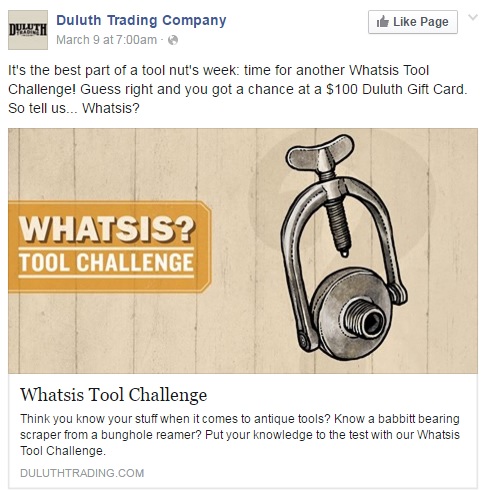 People who like to identify obscure tools! That seemed like a golden opportunity, so I posted the following comment on Duluth's Facebook thread:  I subsequently added a comment with a link to my blog entry Google, to give people more information about the "thingy". Over the next few days, various guesses were made, including a "sediment bowl assembly" and a "cable sheave axle". Click here if you'd like to see the entire discussion on Facebook. Note that to see all of it, you will have to click on Facebook's "view previous replies" and "view more replies" links to expand them. But finally on March 19, a week and a day after my original posting, the following appeared: 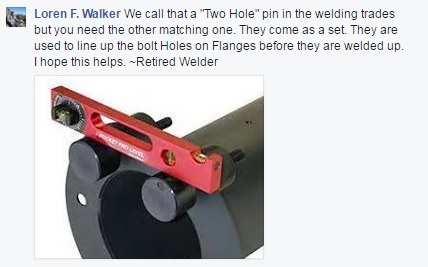 I posted a response, saying, "That's it! You got it, Loren - mystery solved! I'll update my web page soon to reveal the answer to my readers. If you have no objection, I'll give you credit by including a screen shot of your reply, as seen just above. I did a Google search on [welding two-hole pin]. It seems to also be called a "flange pin", and the search turned up a page by Staples with a photo that pretty much exactly matches what I found (except mine is rusted). See: http://www.staples.com/Sumner-Flange-Pin-5-8-1-5-8-in-4-lbs/product_712027." Here's what the picture on that Staples page looks like: 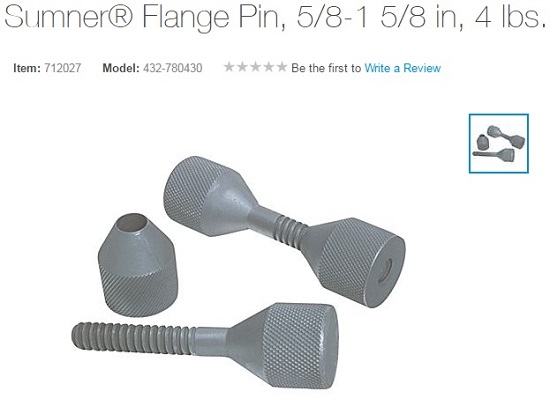 These are obviously the same as my "thingy". As Loren noted in his reply, shown above, "They are used to line up the bolt holes on flanges before they are welded up." Because of the taper, if they are tightened up on a pipe flange hole, they will center themselves on the hole. If a level is then laid across the two pins and used to level them, the result will be to level the two flange holes that the pins are centered on. Here's a video showing the leveling operation. Note that in the video, the flange has been pushed onto the pipe, but can still move around. Only after it is properly leveled will it be welded to the pipe. I think the welder usually starts with a couple of "tack" welds, then removes the level and pins, and completes the full welding operation to permanently attach the flange to the pipe. Note 1 The video shows a version of the pins which is fancier than mine in two respects. First, the levels are built in to the pins, instead of being in a separate tool. Secondly, the nuts are push-button "Quik Pin" nuts, which means they don't have to be turned all the way up the bolt threads. Instead, by pushing a button on the nut, it can quickly be slid most of the way up the bolt. Then, when the button is released, it engages the thread, so the nut can be tightened.
As if to highlight the incongruity of such a product being carried by Staples, the page offering the product also displayed the offers shown in the image to the right. That's right, you can also buy a 2-year or 3-year Electronics Protection Plan for your flange pins! It seems to me that the prices are a bit excessive, given that the pins are solid steel, and contain no electronic components whatsoever. Thus, an electronic failure seems highly unlikely - indeed, impossible. Nevertheless, Staples apparently thinks you can't be too careful! So there is a way to identify a picture of something unknown: post it in a few places where it has a chance of being of interest, and see what the large Internet community can come up with. Thanks, Loren. Mystery solved.
  Note 1:
Here's a link to the same video on YouTube. It's seen above as I found it, embedded in the web page of the manufacturer, the Sumner Manufacturing Company Inc. But I thought it would be a good idea to also link to the YouTube version, because Sumner might change or delete their page at some point in the future, whereas YouTube videos seem to stay around forever. [return to text]
 |
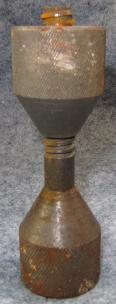
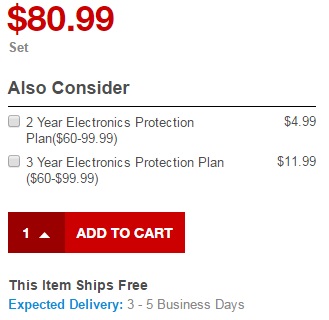 It struck me as odd that the Sumner Flange Pins are offered for sale by Staples. Staples!?! Aren't they an office supply company? What are they doing selling welding tools?
It struck me as odd that the Sumner Flange Pins are offered for sale by Staples. Staples!?! Aren't they an office supply company? What are they doing selling welding tools?